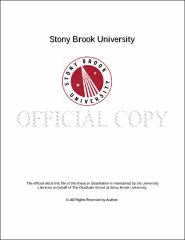| dc.identifier.uri | http://hdl.handle.net/11401/77626 | |
| dc.description.sponsorship | This work is sponsored by the Stony Brook University Graduate School in compliance with the requirements for completion of degree. | en_US |
| dc.format | Monograph | |
| dc.format.medium | Electronic Resource | en_US |
| dc.language.iso | en_US | |
| dc.publisher | The Graduate School, Stony Brook University: Stony Brook, NY. | |
| dc.type | Dissertation | |
| dcterms.abstract | The adenovirus L4-22K protein is multifunctional and critical for different aspects of viral infection. Following DNA replication, increasing amounts of the L4-22K protein are observed prior to the appearance of other late viral proteins. We found that L4-22K controls viral gene expression at the post-transcriptional level and regulates the accumulation of the L4-33K protein, another critical viral regulator, at the level of alternative pre-mRNA splicing. This initiates an activation cascade of late viral proteins, while early genes are being turned off. To gain a better understanding of the mechanism of action of L4-22K, we sought to map the critical elements responsible for L4-22K-mediated splicing of the L4-33K mRNA. We show that activation of L4-33K splicing by L4-22K requires the enhancer element, a cis-acting sequence located at the 3' splice site of the L4-33K pre-mRNA. This element is necessary for L4-22K-mediated activation but it is not sufficient. Furthermore, we found that regulatory sequences located in the second exon of the L4-33K pre-mRNA prevent constitutive splicing of the transcript. We propose that the repressive effect of these putative elements on L4-33K splicing is relieved by the L4-22K protein acting in cooperation with a yet unknown cellular factor. The action of L4-22K protein results in the strict temporal regulation of gene expression during the virus replication cycle. The late phase of the adenovirus life cycle is focused on producing sufficient quantities of structural proteins to assemble the capsid and package the viral genome. Packaging of the viral genome into an empty capsid absolutely requires the binding of L4-22K protein to packaging sequences in a complex with other viral proteins. We focused on the role of conserved pairs of cysteine and histidine residues in the C-terminal region of L4-22K protein. We reveal that the conserved cysteine residues are required for optimum levels of viral genome packaging, but are dispensable for the ability of the L4-22K protein to regulate viral gene expression. These results demonstrate that these two functions of L4-22K may be uncoupled. We propose that the L4-22K protein may serve as a useful target for antiviral therapy since it provides critical functions at different steps in the viral life cycle. | |
| dcterms.available | 2017-09-20T16:53:04Z | |
| dcterms.contributor | Krug, Laurie | en_US |
| dcterms.contributor | Hearing, Patrick | en_US |
| dcterms.contributor | Wimmer, Eckard | en_US |
| dcterms.contributor | Krainer, Adrian | en_US |
| dcterms.contributor | Hearing, Janet. | en_US |
| dcterms.creator | Guimet, Diana | |
| dcterms.dateAccepted | 2017-09-20T16:53:04Z | |
| dcterms.dateSubmitted | 2017-09-20T16:53:04Z | |
| dcterms.description | Department of Genetics. | en_US |
| dcterms.extent | 208 pg. | en_US |
| dcterms.format | Application/PDF | en_US |
| dcterms.format | Monograph | |
| dcterms.identifier | http://hdl.handle.net/11401/77626 | |
| dcterms.issued | 2014-12-01 | |
| dcterms.language | en_US | |
| dcterms.provenance | Made available in DSpace on 2017-09-20T16:53:04Z (GMT). No. of bitstreams: 1
Guimet_grad.sunysb_0771E_12155.pdf: 2356635 bytes, checksum: 4e497b08b76008691b7a7787c2db936c (MD5)
Previous issue date: 1 | en |
| dcterms.publisher | The Graduate School, Stony Brook University: Stony Brook, NY. | |
| dcterms.subject | Microbiology | |
| dcterms.title | The Adenovirus L4-22K Protein Serves as the Master Regulator to Coordinate Late Gene Expression and Viral DNA Packaging | |
| dcterms.type | Dissertation | |

